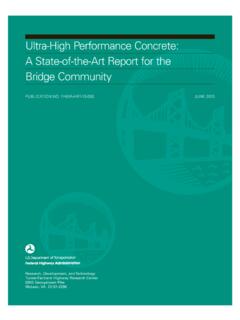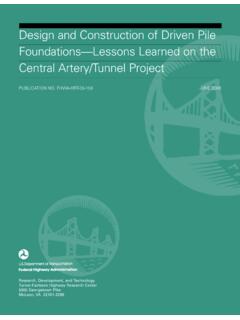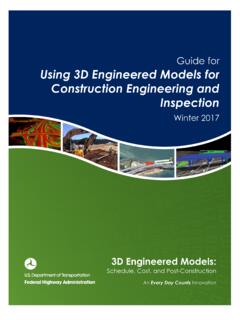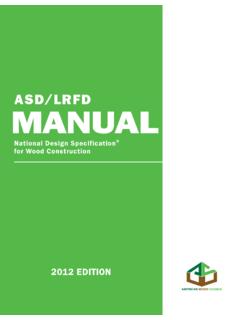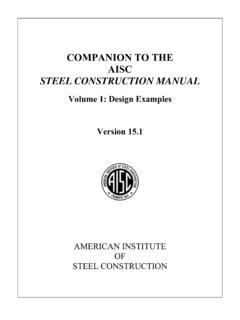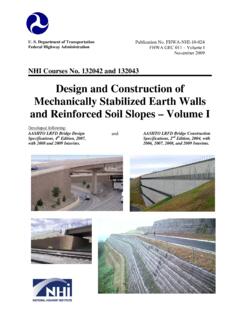Transcription of Implementation of LRFD Geotechnical Design for Bridge ...
1 Department of Transportation Publication No. FHWA NHI-10-039 Federal Highway Administration February 2011 NHI Courses No. 132083 _____ Implementation of lrfd Geotechnical Design for Bridge Foundations Reference Manual State DOT lrfd Design Guidance for Bridge Foundation National Highway Institute 1 NOTICE The contents of this manual reflect the views of the authors, who are responsible for the facts and the accuracy of the data presented herein. The contents do not necessarily reflect policy of the Department of Transportation. This manual does not constitute a standard, specification, or regulation. The United States Government does not endorse products or manufacturers. Trade or manufacturer's names appear herein only because they are considered essential to the objective of this document 2 Technical Report Documentation Page 1.
2 REPORT NO. 2. GOVERNMENT ACCESSION NO. 3. RECIPIENT'S CATALOG NO. FHWA NHI-10-039 4. TITLE AND SUBTITLE 5. REPORT DATE October 2010. Implementation OF lrfd Geotechnical Design Updated Draft, February 2011 FOR Bridge FOUNDATIONS 6. PERFORMING ORGANIZATION CODE 7. AUTHOR(S) 8. PERFORMING ORGANIZATION REPORT NO. Naser Abu-Hejleh, , ; Jerry A. DiMaggio, ;William M. Kramer, ; Scott Anderson, , ; Silas Nichols, 9. PERFORMING ORGANIZATION NAME AND ADDRESS 10. WORK UNIT NO. FHWA Resource Center 11. CONTRACT OR GRANT NO. 12. SPONSORING AGENCY NAME AND ADDRESS National Highway Institute 13. TYPE OF REPORT & PERIOD COVERED Federal Highway Administration Department of Transportation 14. SPONSORING AGENCY CODE Washington, 15. SUPPLEMENTARY NOTES FHWA COTR Louisa Ward 16. ABSTRACT. This document is the reference manual for NHI training course No.
3 132083, both developed to assist State Departments of Transportation (DOTs) in the successful development of lrfd Design Guidance for Bridge foundations based on the 2010 AASHTO lrfd Bridge Design Specifications and their local experiences. Initially, an lrfd Implementation Plan of six consecutive steps is discussed and the remainder of the manual presents recommendations to assist DOTS with Implementation of these steps. The principal changes in the AASHTO Design specifications from ASD to lrfd are presented. The DOTs have three options for selection of lrfd Geotechnical Design methods: adoption of AASHTO s lrfd methods or development of local lrfd methods by fitting to ASD or through reliability analysis of information collected at load test sites. The calibration methods and conditions for these three options are discussed to assist DOTs in Implementation of these options.
4 Procedures are furnished to evaluate and address the project site variability. Then, the three Implementation options are evaluated and compared to assist DOTs with selection of the most appropriate option. The advantages of development of local reliability-based lrfd Design methods over other Implementation options are demonstrated. The Implementation of AASHTO lrfd for Geotechnical Design for Bridge foundations will lead to savings or to equivalent foundation costs compared with ASD methods. At the end, a roadmap for development of lrfd Design guidance that consists of lrfd Design specifications and delivery processes for Bridge foundations is discussed. 17. KEY WORDS: AASHTO, lrfd , ASD, limit 18. DISTRIBUTION STATEMENT states, foundations, safety factor, resistance factor, calibration, conditions, reliability, load No restrictions.
5 Tests, Design , construction, NCHRP Report 507 19. SECURITY CLASSIF. 20. SECURITY CLASSIF. 21. NO. OF PAGES 22. PRICE Unclassified Unclassified 97 3 SI CONVERSION FACTORS APPROXIMATE CONVERSIONS FROM SI UNITS Symbol When You Know Multiply By To Find Symbol LENGTH mm m m km millimeters meters meters kilometers inches feet yards miles in ft yd mi AREA mm2 m2 m2 ha km2 square millimeters square meters square meters hectares square kilometers square inches square feet square yards acres square miles in2 ft2 yd2 ac mi2 VOLUME ml l m3 m3 millimeters liters cubic meters cubic meters fluid ounces gallons cubic feet cubic yards fl oz gal ft3 yd3 MASS g kg tonnes grams kilograms tonnes ounces pounds tons oz lb tons TEMPERATURE C Celsius C + 32 Fahrenheit F WEIGHT DENSITY kN/m3 kilonewton / cubic meter poundforce / cubic foot pcf FORCE and PRESSURE or STRESS N kN kPa kPa newtons kilonewtons kilopascals
6 Kilopascals 225 poundforce poundforce poundforce / square inch poundforce / square foot lbf lbf psi psf iv FORWARD State departments of transportation (DOTs) are at various stages of implementing the AASHTO Load and Resistance Factor Design ( lrfd ) specifications (AASHTO lrfd , 2007) for the Design of Bridge foundations. Some DOTs still use the allowable stress Design (ASD) method (AASHTO Standard Specifications, 2002) for the Geotechnical Design of foundations. Other DOTs have developed lrfd Design manuals that heavily refer to AASHTO lrfd without fully understanding the impact of these specifications on their Design practices or the conditions they should adhere to when using them. Engineers from several DOTs have expressed an interest in having some form of guidance on how to implement the AASHTO lrfd Design specifications with consideration of their local experiences.
7 Consequently, the Federal Highway Administration (FHWA) has developed a new web-based National Highway Institute (NHI) training course called Implementation of lrfd Geotechnical Design for Bridge Foundations. The goal of this training course is to assist DOTs in the successful development of lrfd Design Guidance for Bridge foundations based on the 2010 AASHTO lrfd Bridge Design Specifications and with the consideration of their local experience. This manual is the reference manual for this course and includes seven chapters, with each chapter serving as a reference to a lesson in the training course. Note that this course supplements NHI Course 130082 lrfd for Highway Bridge Substructures and Earth Retaining Structures as it covers additional and more specific guidance to assist DOTs with Implementation of lrfd .
8 It is hoped that that this course will help DOTs with their successful Implementation of AASHTO lrfd and address their specific local lrfd Implementation issues. Improvements to the AASHTO lrfd platform will continue in the future based on applied research studies, the results of additional load tests, and the experience of the highway community with Implementation of lrfd . The lrfd reliability calibration process is a dynamic process: it allows for continued refinement of the resistance factors with more data. DOTs will need to keep updating their own lrfd Design specifications to keep pace with future refinements and updates of AASHTO lrfd . This course will continue to be updated in the future to address any errata, include new improvements, and to reflect new revisions in the AASHTO lrfd Geotechnical Design specifications for Bridge foundations.
9 V TABLE OF CONTENTS CHAPTER 1: CHAPTER 2: lrfd Implementation CHAPTER 3: CHANGES IN THE AASHTO Design SPECIFICATION FROM ASD TO INCORPORATION OF LIMIT STATE Overview of the AASHTO lrfd Limit State Design for Bridge Addressing All Applicable Structural and Geotechnical Limit 3-3 LOAD AND RESISTANCE FACTORS TO ACCOUNT FOR Design UNCERTAINTIES ..3-5 Load Combinations, Load Factors, and Resistance Factors at Various Limit Resistance Factors at the Strength Load Combinations and Factors at the Strength NEW AND IMPROVED METHODS TO DETERMINE LOADS, RESISTANCES, AND Examples of Improved AASHTO Methods to Determine Improved AASHTO Methods to Determine Foundation Displacements and CHAPTER 4.
10 CALIBRATION METHODS FOR Geotechnical RESISTANCE CALIBRATION BY FITTING TO ASD RELIABILITY ANALYSIS OF DATA COLLECTED AT LOAD TEST Compilation of Information at Load Test Statistical Analysis to Account for Design /Construction Reliability Analysis to Determine Resistance Evaluation of Economics and Improvement of Accuracy of the Calibrated Design AASHTO S lrfd CALIBRATION AASHTO s Resistance Factors for Driven Piles and Drilled CHAPTER 5: CALIBRATION CONDITIONS AND ASSESSMENT OF SITE AASHTO S lrfd Design vi Construction and Load Testing Calibration Analysis Methods and SELECTION OF CONDITIONS FOR LOCAL Conditions from AASHTO s Reliability Statistical and Reliability ..5-7 Local Design and Construction Conditions at Load Test ASSESSMENT OF SITE Evaluation of Site Addressing Site CHAPTER 6: SELECTION OF lrfd Geotechnical Design METHODS COMAPRSION OF 2010 AASHTO lrfd AND AASHTO Drilled Driven COMPARISON OF AASHTO lrfd AND LOCAL ASD Selection of Local ASD Design Method to Develop the lrfd Design ADVANTAGES OF LOCAL RELIABILITY Advantages of Reliability Calibration over Calibration by Advantages of Local over AASHTO Reliability SUMMARY AND 7.


